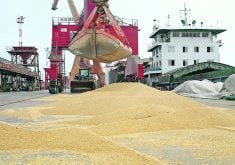Pea traders are keeping their fingers crossed that the new Winnipeg Commodity Exchange field pea contract will work.
But few are banking on it.
“I’m wishing, I’m hoping that it will trade,” said Xcan Grain Pool Ltd. pea trader Mavis Wilson.
“I’m not sure if it will.”
Traders say the new contract, to be introduced July 25, could serve a useful role in giving buyers and sellers of peas some way to manage price risk. But while the revised contract has many altered specifications, some think they may not be profound enough to dispel the lack of interest that doomed two other versions of the contract.
Read Also

Trump’s tariffs take their toll on U.S. producers
U.S. farmers say Trump’s tariffs have been devastating for growers in that country.
The old field pea contract was halted in the spring after going for months without a trade. At the same time, the oat contract, which had also not traded for months, was delisted.
Exchange officials said they were abandoning the oat contract because there was no way to improve it. It was technically sound, meaning its values accurately reflected the underlying cash market, but traders just didn’t want to use it.
Officials said they were holding onto the pea contract because they believed it could be repackaged in a way that the trade would find useful.
“Everyone in the trade said they wanted to see a feed pea contract out there,” said Bruce Love, the exchange’s director of marketing, when the revisions were announced.
The new design is based on net tonnes at seven prairie collection points, with no foreign material element. It provides premiums and discounts based on the underlying cash market.
Previously, delivery could be made anywhere in Western Canada, which created uncertainty for those who stood for delivery. A minimum four percent foreign matter deduction discouraged seed cleaning since sellers couldn’t recoup the value they had added.
Without a working field pea futures contract, buyers and sellers have had few options to manage their risk.
“You put your cash sales on and hope you’re using the right levels that you’re able to buy your cash product with in the future,” said Wilson.
But she said the question is whether traders see the new contract as different enough from the old one.
“If the last one didn’t trade, I’m not sure why this one would,” she said.
If enough interest does appear, Wilson and other traders said they would use it. But that’s the trick.
“We all have to be thinking the same thing to get some liquidity into it, because if only two or three of us want to trade it, it’s not going to trade enough to be viable,” said Wilson.
Other traders said while they’d like to see a pea contract on the exchange, they’re not that desperate for it.
“The trade in general hasn’t been looking at it at all,” said one trader.
“That’s the problem.”
Another, Ken Hooper of Berdex Canada Ltd., said most peas trade outside the loop of commodity exchange member firms and those outside traders have not been involved in the formulation of the new contract.
Many of them will be wary of the new contract because of problems with its previous forms.
“It was so thinly traded that if you got in you couldn’t get out,” said Hooper.
He said many companies tried to use the older versions of the contract, but eventually gave up. To bring them around, the new contract will have to have liquidity and also prove its value to users.
Hooper said the pea business operates on personal contacts between buyer and seller.
“The trade has certainly grown without the hedging capacity,” said Hooper.
Wilson said field peas have traditionally been a cash commodity. Buyers and sellers trade it differently than with flax or canola, which generally sell based on the futures.
Wilson expects the main users of the new contract to be grain companies, with less interest from processors and end users in Europe.
When the new contract goes on the board on July 25 many traders will be hoping it works, but will probably be cautious about joining in themselves.
“You’d like to be able to use it as a risk management tool,” said Wilson. “But I’m not sure it’s different enough.”















